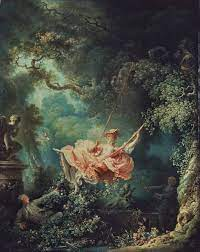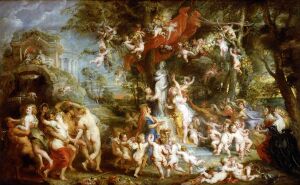Rococo (grupo 2)
What is Rococo Art?
The Rococo was an artistic movement of French European origin, which developed a provocative and cheerful style, in addition to excessive decoration.
It had a scope that covered painting, decorative arts, architecture and sculpture.
The name Rococo comes from the term "Rocaille", a decorative garden technique used with the use of pebbles and seashells, especially popular in France and Italy during the 17th century.
This effect caused the term Rococo to be awarded to this style, due to the effects achieved.
How did the art of Rococo come about?
Its development began at the beginning of the 18th century, during the transition period between the Baroque movement and Neoclassical art.
Despite the fact that these currents have in common the interest in detail, this is differentiated by its dramatic and solemn style for fun and pleasure.
Such was the fact of fun, that the Rococo did not respect the State and much less the Church. For the artistic period, it was more important to enhance everydayness and sensuality than temporal and spiritual details.
Characteristics of rococo art
Rococo art differs from Baroque art because it gives off joy and celebration for life. His intention is to give space to humor, light eroticism and grace.
It could even be said that in reality, during this period, what stood out attractive was the expression of a social class that discarded boredom, through an enthusiastic medium, without didactics and without transcendental pretensions.
Expression of mischief and humor
Rococo equals a European elite that exudes fun. Therefore, it is observed that a large dose of mischief and humor emanates, leaving aside any hint of solemnity. Which indicates that this movement expresses the relaxation of etiquette and any protocol.
- Topics without moral or didactic claim
The most representative themes in the Rococo period were sentimental adventures, the amusements of the idle European elite, pastoral scenes and domestic life. All of them had a connection to the experience, despite the sweetness of the scenes.
However, although they did not attach great importance to it, mythological, religious and historical scenes continued to be represented, but their solemnity was withdrawn. For this style, the didactic and moralizing theme that enhanced power was forgotten.
Imaginative and sumptuous decorations
The technique used to add pleasure and grace to the works, was to change the palette of earthy, intense and dark colors for other more white and pastel colors. This was an inspiration not only for painting, but also for decoration in architecture, which gave the finish a touch full of sensuality and joy.
- Eliminated the propaganda function
The Rococo had so many influences that it freed art from its propagandist role. This was no longer involved in the service of absolutist and ecclesiastical causes, which influenced the style, theme and freedom.
This fact meant that art no longer reacted as a vehicle for seriousness and truth, but rather to be placid.
rococo painting
The painting from the Rococo was a success of Rubenism that surpassed Poussinism.
The first term is known as that current of pictorial artists that color prevailed over drawing, due to the fact that they were inspired by the Baroque painter of Flemish origin, Pedro Pablo Rubens, who was born in 1577 and died in 1640.
Antoine Watteau (1684-1721) was a painter from the Flemish tradition, which had been annexed to the French country. He is remembered as the first painter dedicated to initiating the concerns of the idle European elite.
Although, he was also the one who dedicated himself to giving humanity to his characters. Among the most important works that can be seen by him are the Venetian Party, The Scale of Love and the Pilgrimage on the Island of Cithera.

